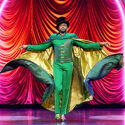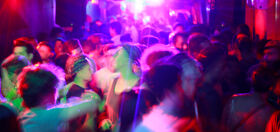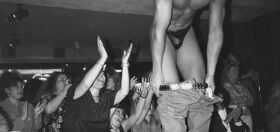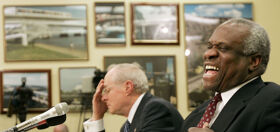
It feels sort of funny to be here, closing out the twenty-first century’s first decade, congratulating a major university for opening a LGBT student center. Because, really? You don’t have one already? But no, Georgetown University didn’t.
University elders will point to Georgetown’s Jesuit foundation as to why the school simply couldn’t offer support to queer students — because it would violate the Roman Catholic Church’s teachings. So why not?
Oh, because two anti-gay attacks in 2007 generated so much media attention, Georgetown had little option but to adequately respond.
The center was the university’s response to two reported anti-gay attacks on students near campus in fall 2007. In one of the two cases, a sophomore was charged with assaulting a fellow student. Prosecutors later dropped the case, citing a lack of evidence, but the event generated publicity and student protests.
Within weeks, Georgetown President John J. DeGioia organized work groups to study how hate crimes are reported, what additional resources gay students needed and how the entire campus was educated on including and understanding gay students.
It’s a terrible thing to require — violent attacks on students — to throw some momentum behind a Georgetown-funded LGBT center. But we’ll take it. Particularly because previous efforts came up short:
How about we take this to the next level?
Our newsletter is like a refreshing cocktail (or mocktail) of LGBTQ+ entertainment and pop culture, served up with a side of eye-candy.
Gay students at Georgetown first organized in the 1970s, just after the American Psychiatric Association removed homosexuality from its official list of mental disorders. The students repeatedly petitioned the university for recognition and resources. They were denied over and over.
In the 1980s two groups representing gay undergraduates and law students sued Georgetown under the D.C. Human Rights Act, which says it is illegal to discriminate based on sexual orientation. In 1987, an appeals court decided that although the university is not required to endorse the group, it cannot deny students access to resources and benefits enjoyed by other campus clubs. Today that group is called GUPride.
In 2002, students again petitioned the administration, this time for a resource center. They were turned down, but as a compromise, in 2004, the university dedicated a part-time employee to advise gay student on what resources were available on campus.
But even a LGBT student center probably won’t prevent things like this.



















AndrewW
Catholics can be soooooo slow.
trickstertara
Hiding behind Catholic doctrine is a joke. Many Catholic universities have LGBT student groups. DePaul University in Chicago has an LGBTQA student affairs *office* for fuck’s sake. Georgetown’s elders were just digging their heels in out of bigotry.
CCCole
Psh, the College of William and Mary doesn’t have an LGBT student center and we’re a secular state school. We LGBTs were just included in the sphere of concern of the Student Diversity Center (which changed its name from the Multicultural Center to be more inclusive). Not to knock the College- the new assistant director of the center is queer and a former LGBT center director, and queer students were allowed in on the selection process.
Forrest
Agreed. Many colleges do not have centers but still provide outreach. I went to The College of Charleston in SC. Gasps of horror I know but Charleston has LGBT housing and employment ordinances. The College sponsors a Safe Zone program,and has gay studies courses along with a GSA. Lane Hudson who broke the Mark Foley scandal also went to COFC. Nick Shalosky a current student was recently elected to the local school board as the first openly gay public official in SC.
My alma mater still has a long way to go but so do most schools.
Dale
Okay, I live in Washington and have friends who went to Georgetown. I was in the student center two years ago and there was a fully-staffed LGBT student affairs office and student gay group on campus. So it’s a little puzzling that you’re trying to imply Georgetown did not have resources for gay students before now. That’s just false. Rather, they’re building an entire student center–something most colleges don’t even have for gay students–as a way of increasing campus awareness. I think it’s a pretty magnanimous move. And I think you guys should get your nose out of Davey Wavey’s ass long enough to get your facts straight. Queerty has more factual errors than Sarah Palin’s Twitter but I chalk it up to the fact that you essentially can’t afford a real editor. In this case you’re either deliberately blurring the line to trash Georgetown or you’re hopelessly misinformed about what actually goes on at at the campus. Either way, I notice you didn’t link to the article you quote.
Keith Kimmel
There are alot of universities that don’t have such a thing. I am still surprised that Oklahoma University event permits a gay student organization. Its quite active, too. But they don’t have a center as far as I know.
Pete
Georgetown University has had a very active gay gay and lesbian group since at least 1985. The Center that this article talks about is a much larger presence. However, it would be a big mistake to report that there were not LGBT student resources or group until this new happening, because I was a member of the Gay and Lesbian Students of Georgetown in the 1980’s.
Joe
I am a current student and I was around (though regrettably not a participant) during the creation of the center. De Gioia was NOT the source of the push for the center, but merely caved to HUGE amounts of pressure from the student and faculty population. The Out For Change campaign, led in part by GU Pride, staged multiple protests, circulated a petition, and put greats amount of pressure on the administration to make the change.
Now I’d hope that Georgetown is on its way to proving that Catholic and bigot are not necessarily congruent.
Needless to say, I’m glad our center made the blog!
DaveO
Why does a college (or anyone else) need an LGBT Center?
Brian
Others have already made this point, but I’ll just pile on. I graduated in ’85, and there was an active gay student group throughout my four years there. They met in university classrooms, posted announcements in university papers etc. It had a barebones budget feel to it, but all the student groups did then. I doubt it had university funding, so maybe that’s what the lawsuit was about. We then built a huge student center, and all student groups got more organised and resourced, including the gay group. This new LGBT center you’re discussing here is just a more souped up, resourced version of what’s been on campus for a long time. I went to harvard business school after georgetown, and gays were invisible there, I don’t even think there was any gay student organization, much less an LGBT center.
I remember there was some scandal when an African cardinal was invited to campus to speak at graduation. He was supposed to speak about bridging the divide between developing and developed nations, but instead launched into an anti gay, anti abortion tirade that would have been music to the pope’s ears. Many professors got up and walked out, and the school administration immediately condemned the speech and sent apologies to all the alumni. Personally I can’t stand the catholic church, but I think Georgetown deserves some credit for working hard to escape from its overlords in Rome.
Anthony
Believe me, anyone really familiar with the Jesuits knows that they’re one of the gayest institutions on earth.
Roger
Georgetown is also the first Catholic-affiliated university to establish an LGBTQ Resource Center. Come on, instead of yelling at GU, let’s use this positive development to hold the other 99% of the Catholic universities to a higher (equal) standard.
Mary
Do you homosexual buffoons really think that you can finesse the Catholic Church through politics to state that homosexuality is good and wholesome, and that somehow this will change God’s mind about this filthy sin?
“Do not be deceived; neither fornicators, nor idolaters, nor adulterers, nor HOMOSEXUALS, nor HOMOSEXUAL prostitutes, nor thieves, nor the greedy, nor drunkards, nor revilers, nor robbers will inherit the kingdom of God.” (1 Corinthians 6:9-10)
The only thing I can figure is that God Himself has hardened your hearts in preparation for judgment, just like he did the Pharaoh (Exodus 4:21, 7:4-5). Initially the Pharaoh hardened his own heart, and eventually God confirmed it. When God wipes His hands of you, then you really don’t have any more hope. Think about it.
Bunny Snuggles
The Ass-holy Virgin (not by choice) Mary wrote:
“Do not be deceived; neither fornicators, nor idolaters, nor adulterers, nor HOMOSEXUALS, nor HOMOSEXUAL prostitutes, nor thieves, nor the greedy, nor drunkards, nor revilers, nor robbers will inherit the kingdom of God.” (1 Corinthians 6:9-10)
——-
Well, there goes Congress and the Vatican!
——–
Here’s a few “cringe worthy” quotes back at you:
1 Corinthians 11:5 But every woman who has her head uncovered while praying or prophesying disgraces her head, for she is one and the same as the woman whose head is shaved.
1 Corinthians 14:34 The women are to keep silent in the churches; for they are not permitted to speak, but are to subject themselves, just as the Law also says.
A woman’s hand must be amputated if she touches a man’s genitals.
“When men strive together one with another, and the wife of the one draweth near for to deliver her husband out of the hand of him that smiteth him, and putteth forth her hand, and taketh him by the secrets: Then thou shalt cut off her hand, thine eye shall not pity her.” — Dt.25:11-12
Sometimes God causes noses and ears to be amputated and forces women to pluck off their own breasts.
And I will set my jealousy against thee, and they shall deal furiously with thee: they shall take away thy nose and thine ears. … Thou shalt even drink it and suck it out, and thou shalt … pluck off thine own breasts: for I have spoken it, saith the Lord GOD. — Ezekiel 23:25, 34
—–(According to LEVITICUS: God Hates Women on the Rag)—–
Leviticus 12
(12:5) “But if she bear a maid child, then she shall be unclean two weeks … and she shall continue in the blood of her purifying threescore and six days.”
If a girl is born, the mother is unclean for 14 days and be purified for 66 days. This is because, in the eyes of God, girls are twice as dirty as boys.
“If a woman have an issue, and her issue … be blood…” (God’s law for menstruating women)
They are unclean and sinful. Anthing that they touch is unclean. Anyone who touches anything that they touch is unclean. Stay completely away from them. (And for God’s sake, don’t even think about having sex with them!) 15:19-30, 33
“If a woman have an issue, and her issue… be blood, she shall be put apart seven days: and whosoever toucheth her shall be unclean until the even.” 15:19
“And every thing that she lieth upon in her separation shall be unclean: every thing also that she sitteth upon shall be unclean.” 15:20
“And whosoever toucheth her bed shall wash his clothes, and bathe himself in water, and be unclean until the even.” 15:21
“Whosoever toucheth any thing that she sat upon shall … be unclean until the even.” 15:22
“And if it be on her bed, or on any thing whereon she sitteth, when he toucheth it, he shall be unclean until the even.” 15:23
“If any man lie with her at all, and her flowers be upon him, he shall be unclean seven days; and all the bed whereon he lieth shall be unclean.” 1524:
“If a woman have an issue of her blood … she shall be unclean.” 15:25
“Every bed whereon she lieth … and whatsoever she sitteth upon shall be unclean.” 15:26
“Whosoever toucheth those things shall be unclean.” 15:27
“But if she be cleansed of her issue, then she shall number to herself seven days, and after that she shall be clean.”
Women are unclean while mestruating and for seven days after bleeding has stopped. 15:28
“On the eighth day she shall take unto her two turtles, or two young pigeons … for a sin offering, and the other for a burnt offering; and the priest shall make an atonement for her before the LORD for the issue of her uncleanness.” 15:29-30
“This is the law of him that hath an issue, and of him whose seed goeth from him … And of her that is sick of her flowers, and of him that hath an issue, of the man, and of the woman, and of him that lieth with her that is unclean.” 15:32-33
A man who has sex with a menstruating woman “shall be unclean seven days.” 15:24
“Also thou shalt not approach unto a woman to uncover her nakedness, as long as she is apart for her uncleanness,” Don’t even look at a menstruating woman. 18:19
If a man has sex with an engaged slave woman, scourge the woman, but don’t punish the man. (Even if he raped her?) 19:20-22
If a man has sex with his father’s wife, kill them both. 20:11
If a man has sex with his daughter in law, kill them both. 20:12
If a man has sex with his wife and her mother (now that sounds like fun!), burn to death all three. 20:14
If a woman “lies with a beast” both the woman and the animal are to be killed. 20:15
If a man has sex with a menstruating woman, they both “shall be cut off from among their people.” 20:18
[attribution to the (un)Holy Bible and to “The Skeptic’s Annotated Bible”]
http://www.skepticsannotatedbible.com/says_about/amputation.html
http://www.skepticsannotatedbible.com/fv/long.html
Bunny Snuggles
@ No. 13 · Mary
So as you can see from the afore mentioned quotes (according to your un-Holy Bible), Mary, when the crimson tide comes to take you out to sea (so to speak)…well… let’s just say that “god” is more than happy to be a “land lubber”.